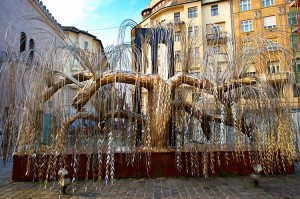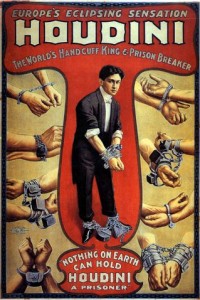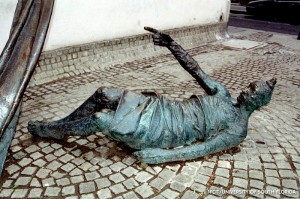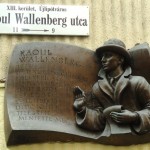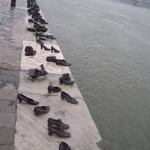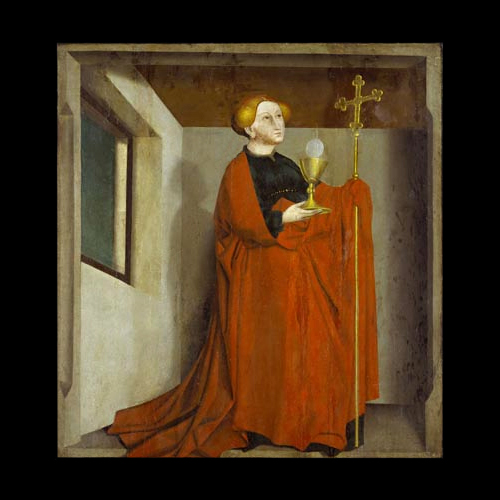The Monument to Hungarian Jewish Martyrs is behind the Moorish-style synagogue fronting Pest’s wartime ghetto. This striking memorial in the form of a weeping willow, each metal leaf inscribed with a name, was erected over the twenty-four mass graves of the Jewish victims of Hungarian Fascism. In all 2,281 corpses are buried there, a fraction of the total who suffered the same fate during the last months of the war.
The synagogue, the second largest in the world, has been renovated partly from funds donated by the actor Tony Curtis’s Emmanuel Foundation. Curtis – born Bernard Schwartz, in the Bronx – is the son of Hungarian immigrants. In 1952 he played the part of Pest’s most famous escape artist, Harry (“Shake me, I’m magic”) Houdini.
Houdini was born Ehrich Weiss, son of Rabbi Weiss, in Pest in 1874. The family fled from Budapest to Appleton, Wisconsin, when Houdini was two. It was the first of his many escapes.
Like its illustrious sons, the streets of the Jewish quarter have hidden connections. In the warren of courtyards between Dob, Király, and Wesselényi streets developers are moving in and tarting up the stucco.
Returnees from America stop in at Fröhlich Cukraszda for kosher strudel, and these days the damp courtyards are used for movie sets with a gangsterish, Blade Runner street-cred. But at night an eerie atmosphere descends and history comes out of the woodwork.
Behind the synagogue a golden angel leans out at right angles from a gable and rescues a man on his back on the cobbles with a length of metal bedsheet. This sculpture is dedicated to the memory of Carl Lutz, the Swiss consul who issued foreign identity passes, the famous Schutzpass, to the ghetto’s inhabitants. Lutz and his colleague Raoul Wallenberg saved tens of thousands of Budapest Jews from the Final Solution in which an estimated 500,000 Hungarian Jews perished.
Wallenberg travelled around Budapest in a Studebaker, never slept in the same house two nights in a row, and wore a broad-brim Eden hat. He supplied food, medicine and warm clothing to those on Eichmann’s forced marches, bribed officials when necessary and retrieved people from the deportation trains – sometimes after they had left.
In April 1948 the Mayor of Budapest was poised to unveil a statue of Raoul Wallenberg, showing him battling with a snake, but Soviet soldiers spirited it away at the last minute. It reappeared two years later outside a pharmaceutical factory in eastern Hungary, its plaque removed, the snake taking on a completely different meaning. Now it’s back on the Pest quay looking towards Margit Island.
Hungarian history sometimes seems like a vaudeville act of appearing and disappearing statues. During the two years when the statue went awol the flesh and blood Wallenberg was moved from Lefortovo Prison in Moscow into the Gulag network of Soviet labour camps, where he disappeared. There have been rumours of sightings ever since.
Survivors of the Gulag system use the expression “our knocking connections” to describe the coded communication from cell to cell. Wallenberg, they report, “was a great knocker”. Those who survived the ghetto still knock on doors using the same code: three times means friend. Knocking habits, like statues, die hard.
A Raoul Wallenberg Street, formerly Phönix Street, leads down to the Danube, in an area, the former “little ghetto”, where the Swedish diplomat established many safe houses. A second statue of Wallenberg, by Imre Varga (who also designed the Holocaust Memorial), was unveiled in 1987. Communist authorities grudgingly wanted the statue erected far from the centre of town. The inscription on it is taken from Ovid’s Tristia – another exile at the hands of empire: Tempora si fverint nubila solus eris: “In stormy times you’re on your own.”
Thousands of Jews were shot and thrown into the Danube by the Arrow Cross, the Right-wing fascist group which seized power on 15 October 1944. They would handcuff their victims together, shoot one, and watch laughing as the other struggled in the freezing current. They attacked the diplomatically protected houses, children’s homes and the Jewish Orphanage. The diary of a child, Tamás Kilényi, captures the fear of the last days of the war. “Three o’ clock at night, we have to get up immediately, we are leaving. We all get a sugar cube. Two Hungarian soldiers come in. They are going to accompany us. We go outside. In the moonshine we slip through the fence, and reach Bogár utca. Bombed out buildings everywhere.” “Then the Danube was not blue but brown, red. Red from the blood of Jews,” another survivor, Eva Bentley, recalls. On the Danube bank there is a pyramid of stones in memory of the dead.
Horror, death and entertainment are uncomfortably close, as Houdini, the manacled diver, knew. Death was a constant companion for the Budapest Jews. Outside the city there is a new resting ground, a Statue Park, for all the big boys currently out of favour. In it Lenin still declaims to the masses, Stalin massively reigns, the Unknown Worker and Ukrainian tractor drivers toil away in stone. This is the heaven of statues. This is where bad history goes when it dies.


